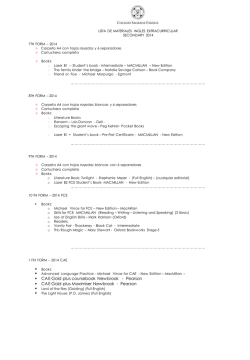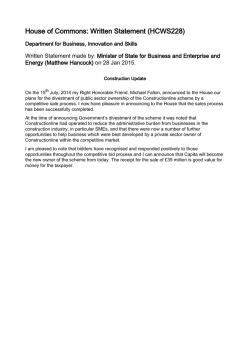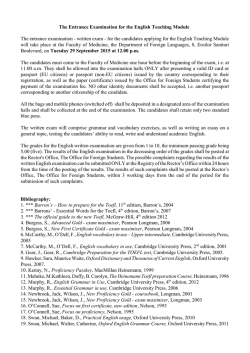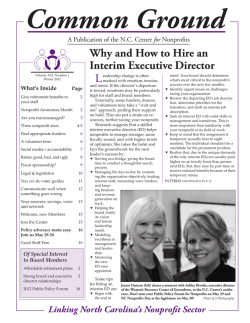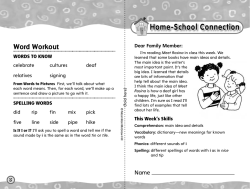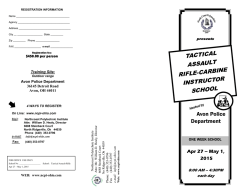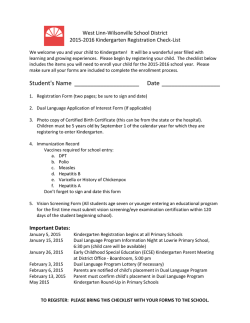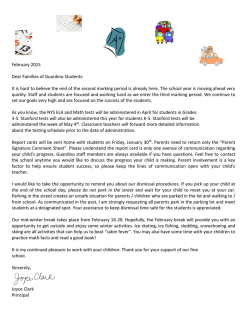
Creating a Strategic Roadmap to the Future
GETTING THERE: CREATING A STRATEGIC ROADMAP TO THE FUTURE Kansas Health Foundation Grant Recognition Conference April 9, 2015 Presented by: Lynne Brown VP Strategic Consulting iBossWell, Inc. Agenda for the Day • The philosophy of growth and • • • • • change An overview of research tools to inform the planning process A review of best practices in nonprofit strategic planning Defining an effective plan structure Writing quality performance measures Building a culture of assessment Why Plan? “When it comes to the future, there are three kinds of people: those who let it happen, those who make it happen, and those who wonder, what happened?” John M. Richardson, Jr. SUCCESSFUL PRACTICES IN STRATEGIC PLANNING ASP Survey of Successful Strategic Planning Practices in the Nonprofit Sector RESEARCH Successful organizations conduct research prior to the planning process Getting Out of Our Own Heads • Staff • Board • Stakeholders • Funders • Partners • Constituents • Twitter/LinkedIn, Facebook • Journals/Conferenc es PEST ANALYSIS Political, Economic, Social and Technological • • • • • • • • • • • • • • • • • • • criteria examples • • • • • • • • • • • • • • • • • • • home economycriteria examples • • • • • • • • • • • • • • • • home economy economy trends overseas economies general taxation taxation specific to product/services seasonality issues market/trade cycles specific industry factors market routes trends distribution trends customer/end-user drivers interest/ exchange rates international trade and monetary issues ecological/environmental current legislation future legislation international legislation regulatory bodies and processes government policies government term and change trading policies funding, grants and initiatives home market pressure- groups international pressure- groups wars and conflicts political economic • • criteria examples ecological/environmental current legislation future legislation international legislation regulatory bodies and processes government policies government term and change trading policies funding, grants and initiatives home market pressure- groups international pressure- groups wars and conflicts political economic • • criteria examples PROGRAM ASSESSMENT MacMillan Matrix and Matrix Mapping Program Assessment: Why Guides organizations in: • Assessing their programs against trends of increasing demand for smaller resources • Gaining greater focus • Avoiding duplication of services • Exploring and increasing opportunities for collaboration • Determining prioritization and divestiture of programs • Advancing organizational sustainability through comparative view of mission-impact: financial sustainability ratio • Apples-to-apples comparison to guide objective discussion Two Approaches • MacMillan Matrix • Developed by I.C. MacMillan, “Competitive Strategies for Not-forProfit Agencies, Advances in Strategic Management 1 (London, JAI Press, Inc., 1983): 61-82 • The Matrix Map • Developed by: Jeanne Bell, Jan Masaoka, Steve Zimmerman Nonprofit Sustainability: Making Strategic Decisions for Financial Viability. Jossey-Bass, San Francisco. 2010 MacMillan Matrix Program Assessment: How Assess each current or prospective program based upon four key criteria: Fit/Alignment with Mission Fit is the degree to which a program “belongs” or fits within an organization. Program Strength – (Competitive Position ) Degree to which program has a strong capability; delivers outcomes Alternative Provider(s) - (Alternative Coverage) Number of other organizations attempting to/delivering similar program in same region to similar constituents Program Resource Attractiveness Degree to which program is attractive to the organization from an economic perspective, as an investment of current/future resources. How easily it attracts resources. Based on response of the 4 bottom-line questions for A thru D, Plot the program on the Matrix MacMillan Matrix A. GOOD FIT With Mission & Abilities A. POOR FIT With Mission & Abilities D.HIGH PROGRAM RESOURCE ATTRACTIVENESS: “Easy” Program D.LOW PROGRAM RESOURCE ATTRACTIVENESS: “Difficult” Program C.Alternative Provider High C.Alternative Provider High C.Alternative Provider Low C.Alternative Provider Low B. Strong Program Strength 1. Compete aggressively 2. Grow Aggressively 5. Support the Best Competitor 6. “Soul of the Organization” B. Weak Program Strength 3. Divest aggressively 4. Build strength or Get Out 7. Divest Systematically 8. Work collaboratively 9. Aggressive Divestment 10. Orderly Divestment 11 Aggressive Divestment 12 Orderly Divestment The Matrix Map: Assuring Impact & Financial Sustainability Purpose and Structure of the Matrix Map: •What are our core business lines—the dual bottom line --How do we determine Profitability --How do we determine relative Impact of our programs & efforts Basic Approach for Matrix Map 1. Identify your "lines of business" or activities, programs, services 2. Determine profitability • Determining Full Costs/Expenses: • Direct costs • Share of common or shared costs • Rent, technology, insurance, supplies, etc. • Share of full administrative costs • FTEs • Some gov. grants limit the overhead 3. Determine types of revenue • Earned Income • Contributed Income 4. Assess relative mission Impact 5. Map the results Mission Impact Criteria (Rated: 1=low impact – 4=very high impact) 1. 2. 3. 4. 5. 6. 7. Alignment with core mission: How closely does this program align with our core goals? Some programs may be excellent, but not as central to our mission. Excellence in execution: How good are we at delivering this program? Do we have the skills/resources to implement with excellence? Scale: How many people does the program/business line affect? Depth: How deep an intervention or contact does the program provide? Can we measure that? Building community or constituency: How does this program contribute to building/advancing the greater good? For example, connection to the Latino community or strengthening a neighborhood (not just the organization)? Fills an Important Gap (FIG): If the program were to go away, would our constituents be able to go across the street to another agency or would they have nowhere to go? Leverage: refers to the degree to which the program increases impact of other programs; e.g. the demand/funding in a field is increasing rapidly; when audiences of one program carry over to other programs; or when a program has marquee value by giving the organization higher visibility and helping with the entire organization’s branding. Mapping the Matrix CREATING THE PLAN Higher performing organizations engage in strategic planning as a routine, periodic process It starts with a vision… • Why do we do what we do? What’s our cause? Vision/Mission? • How do we do that? Big picture strategies and intentions. • What are we going to do to make it happen? What tactics will we employ? *adapted from Sinek’s Golden Circle Strategic Planning – Structure* & Focus Vision/Mission Values 1. Strategic Initiative Focus: Strategic Environmental/ Needs Assessment & SWOT to inform Overarching KPMs/Outcomes 2. Strategic Initiative 2.1. Goal 2.2. Goal Goal 3. Strategic Initiative “KPM” Key Performance Measures /Outcomes Goal Focus: Tactical 2.2.1. Objective 2.2.2. Objective 2.2.2.1. Action Focus: Individual Performance Individual actions tie to Plan Goals Individual Actions Action Individual Actions Objective Accountabilities: Responsible Party, Dates, Resources Action Individual Actions Individual Actions *Nomenclature can be customized Strategic Initiative Goal Objective Action Example • Strategic Initiative 1: Programs & Services Provide high quality services and supports that are innovative and responsive to changing community needs and that promote individual choice and an enhanced quality of life consistent with XYZ values, mission and resources. • Goal 1.1: Quality Assurance/Outcomes Program: Quality Assurance/Outcomes Program: Develop, implement and maintain a quality improvement and outcomes measurement program and process. • Objective 1.1.1: Address Service Capacity Issues: Develop and maintain a process by which we address our service capacity issues and needs, including attendance, interest lists, projected capacity. • Action 1.1.1.1: Measure Service Capacity: A weekly report will be made to the program management teams. Build in Accountability • Assign Primary & Secondary Responsible Parties • Drive plan implementation to every level of the organization • No man, or woman, is an island. • Assign Timeframes • Establish priorities • Consider additional resources required MEASURING SUCCESS Higher-performing organizations have an explicit focus on measuring success. Performance Measurement • “The board, management, and staff take on the challenge of collecting and using information, not because it’s a good marketing tool, and not because a funder said they have to. They believe it is integral to ensuring material, measurable, and sustainable good for the people or causes they serve.” • Management and staff make the collection, analysis, and use of data part of the organization’s DNA. They ensure that people throughout the organization understand the key metrics. • Leaders draw a clear distinction between outputs (e.g., meals delivered, youth tutored) and outcomes (meaningful changes in knowledge, skills, behavior, or status) From the Performance Imperative, A Framework for Social-Sector Excellence, February 2015 Evidence of Success: An Important Continuum and Distinction Activities onto Outcomes on to Impact • How do you identify measures of success, while avoiding analysis paralysis? • Impact vs Outcomes vs Activities – What’s really important? • What do your stakeholders care about? • And what really matters at the end of the day? Examples for a Local Health Department Goal: Decrease incidence of diseases preventable through immunization. • Activities: Increase in number of immunization clinics offered monthly. • Outcomes: Increase by five percent annually the number of children receiving AAP recommended immunizations. • Impact: By 2020, no cases of immunization preventable diseases reported in county. How to handle all three elements in your plan • Activities: are the “Action” needed to reach Outcomes/Impact • Document in the tactical section of plan (implementation) • Outcomes: are evidence of success, sometimes the desired endpoint • Document in Goal related Key Performance Measure/Success Measure section of plan • Impact: highest level of evidence that you are meeting your Mission/Goal • Document in Overarching Key Performance Measure or Goal Key Performance Measure/Success Measure section of plan THE SECRET TO SUCCESS… Higher performing organizations are committed to a regular schedule of plan assessment and reporting "Vision without execution is hallucination" Thomas Edison The Philosophy of Implementation & Assessment: Continuous Improvement Build a Culture of Implementation • Make plan assessment a habit: Establish a calendar for assessment • How often to assess? • Who needs to see results and when? • Align board committees with plan initiatives Assessment Practices • Assess from the bottom, up • Clearly define staff/board roles and responsibilities in the assessment process • Who assesses at what level? • Typically: • Staff/board committees at Tactical Level • Staff leadership/board at Goal/Metric level • Sharing the reports • Establish P&Ps on how plan changes will be suggested/approved Plan Assessment & Scorecard WePlanWell TM Honest, Open, Thoughtful and Fair Discussion Copyright iBossWell, Inc. 2006 “Greatness is not a function of circumstance. Greatness, it turns out, is largely a matter of conscious choice, and discipline.” Jim Collins Good to Great in the Social Sector For additional information and/or Copyright Use Permission Contact: Lynne Brown VP Strategic Consulting iBossWell, Inc. 5600 W. 95th Street, Suite 108 Overland Park, KS 66207 [email protected] 913-642-1416 www.ibosswell.com This presentation is copyright of iBossWell, Inc. 2015. All rights reserved.
© Copyright 2025
